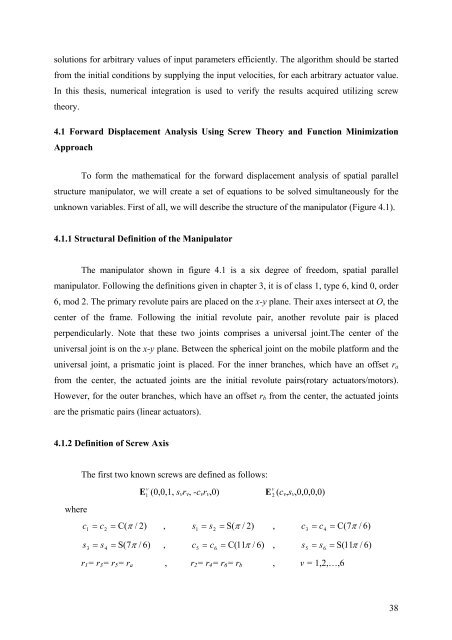Kinematic and Dynamic Analysis of Spatial Six Degree of Freedom ...
Kinematic and Dynamic Analysis of Spatial Six Degree of Freedom ...
Kinematic and Dynamic Analysis of Spatial Six Degree of Freedom ...
Create successful ePaper yourself
Turn your PDF publications into a flip-book with our unique Google optimized e-Paper software.
solutions for arbitrary values <strong>of</strong> input parameters efficiently. The algorithm should be started<br />
from the initial conditions by supplying the input velocities, for each arbitrary actuator value.<br />
In this thesis, numerical integration is used to verify the results acquired utilizing screw<br />
theory.<br />
4.1 Forward Displacement <strong>Analysis</strong> Using Screw Theory <strong>and</strong> Function Minimization<br />
Approach<br />
To form the mathematical for the forward displacement analysis <strong>of</strong> spatial parallel<br />
structure manipulator, we will create a set <strong>of</strong> equations to be solved simultaneously for the<br />
unknown variables. First <strong>of</strong> all, we will describe the structure <strong>of</strong> the manipulator (Figure 4.1).<br />
4.1.1 Structural Definition <strong>of</strong> the Manipulator<br />
The manipulator shown in figure 4.1 is a six degree <strong>of</strong> freedom, spatial parallel<br />
manipulator. Following the definitions given in chapter 3, it is <strong>of</strong> class 1, type 6, kind 0, order<br />
6, mod 2. The primary revolute pairs are placed on the x-y plane. Their axes intersect at O, the<br />
center <strong>of</strong> the frame. Following the initial revolute pair, another revolute pair is placed<br />
perpendicularly. Note that these two joints comprises a universal joint.The center <strong>of</strong> the<br />
universal joint is on the x-y plane. Between the spherical joint on the mobile platform <strong>and</strong> the<br />
universal joint, a prismatic joint is placed. For the inner branches, which have an <strong>of</strong>fset ra<br />
from the center, the actuated joints are the initial revolute pairs(rotary actuators/motors).<br />
However, for the outer branches, which have an <strong>of</strong>fset rb from the center, the actuated joints<br />
are the prismatic pairs (linear actuators).<br />
4.1.2 Definition <strong>of</strong> Screw Axis<br />
where<br />
The first two known screws are defined as follows:<br />
v<br />
E 1 (0,0,1, svrv, -cvrv,0)<br />
v<br />
E 2 (cv,sv,0,0,0,0)<br />
c = c = C( π / 2)<br />
, s = s = S( π / 2)<br />
, c = c = C( 7π<br />
/ 6)<br />
1<br />
2<br />
1<br />
2<br />
s = s = S( 7π<br />
/ 6)<br />
, c = c = C( 11π<br />
/ 6)<br />
, s = s = S( 11π<br />
/ 6)<br />
3<br />
4<br />
5<br />
r1= r3= r5= ra , r2= r4= r6= rb , v = 1,2,…,6<br />
6<br />
3<br />
5<br />
4<br />
6<br />
38
















